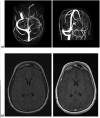A Difficult Decision: Atypical JC Polyomavirus Encephalopathy in a Kidney Transplant Recipient
- PMID: 27367472
- PMCID: PMC5201453
- DOI: 10.1097/TP.0000000000001275
A Difficult Decision: Atypical JC Polyomavirus Encephalopathy in a Kidney Transplant Recipient
Abstract
Background: A number of cerebral manifestations are associated with JC polyomavirus (JCPyV) which are diagnosed by detection of JCPyV in cerebrospinal fluid (CSF), often with the support of cerebral imaging. Here we present an unusual case of a kidney transplant patient presenting with progressive neurological deterioration attributed to JCPyV encephalopathy.
Methods: Quantitative polymerase chain reaction JCPyV was used prospectively and retrospectively to track the viral load within the patient blood, urine, CSF, and kidney sections. A JCPyV VP1 enzyme-linked immunosorbent assay was used to measure patient and donor antibody titers. Immunohistochemical staining was used to identify active JCPyV infection within the kidney allograft.
Results: JC polyomavirus was detected in the CSF at the time of presentation. JC polyomavirus was not detected in pretransplant serum, however viral loads increased with time, peaking during the height of the neurological symptoms (1.5E copies/mL). No parenchymal brain lesions were evident on imaging, but transient cerebral venous sinus thrombosis was present. Progressive decline in neurological function necessitated immunotherapy cessation and allograft removal, which led to decreasing serum viral loads and resolution of neurological symptoms. JC polyomavirus was detected within the graft's collecting duct cells using quantitative polymerase chain reaction and immunohistochemical staining. The patient was JCPyV naive pretransplant, but showed high antibody titers during the neurological symptoms, with the IgM decrease paralleling the viral load after graft removal.
Conclusions: We report a case of atypical JCPyV encephalopathy associated with cerebral venous sinus thrombosis and disseminated primary JCPyV infection originating from the kidney allograft. Clinical improvement followed removal of the allograft and cessation of immunosuppression.
Figures




Similar articles
-
Archetype JC Polyomavirus (JCPyV) Prevails in a Rare Case of JCPyV Nephropathy and in Stable Renal Transplant Recipients With JCPyV Viruria.J Infect Dis. 2017 Nov 15;216(8):981-989. doi: 10.1093/infdis/jix435. J Infect Dis. 2017. PMID: 28968776
-
High-level JCPyV viruria after kidney transplantation-Clinical and histopathological findings.J Clin Virol. 2016 Dec;85:75-79. doi: 10.1016/j.jcv.2016.10.018. Epub 2016 Nov 2. J Clin Virol. 2016. PMID: 27842264
-
Polyoma nephropathy and progressive multifocal leukoencephalopathy in a renal transplant recipient.J Child Neurol. 2004 Apr;19(4):301-4. doi: 10.1177/088307380401900412. J Child Neurol. 2004. PMID: 15163098
-
JC virus-associated nephropathy in a renal transplant recipient and comparative analysis of previous cases.Transpl Infect Dis. 2011 Feb;13(1):89-92. doi: 10.1111/j.1399-3062.2010.00567.x. Epub 2010 Sep 6. Transpl Infect Dis. 2011. PMID: 21299772 Review.
-
A Kidney Transplant Recipient With Fulminant Progressive Multifocal Leukoencephalopathy-Immune Reconstitution Inflammatory Syndrome: A Rare Clinical Outcome and Review of the Literature.Exp Clin Transplant. 2020 Apr;18(2):242-246. doi: 10.6002/ect.2018.0227. Epub 2019 Oct 1. Exp Clin Transplant. 2020. PMID: 31580233 Review.
Cited by
-
Molecular epidemiology of JC polyomavirus in HIV-infected patients and healthy individuals from Iran.Braz J Microbiol. 2020 Mar;51(1):37-43. doi: 10.1007/s42770-019-00117-y. Epub 2019 Jul 30. Braz J Microbiol. 2020. PMID: 31364012 Free PMC article.
-
John Cunningham Virus and Progressive Multifocal Leukoencephalopathy: A Falsely Played Diagnosis.Diseases. 2024 May 13;12(5):100. doi: 10.3390/diseases12050100. Diseases. 2024. PMID: 38785755 Free PMC article. Review.
-
Rare Causes of Cerebral Venus Sinus Thrombosis: A Systematic Review.Life (Basel). 2023 May 12;13(5):1178. doi: 10.3390/life13051178. Life (Basel). 2023. PMID: 37240823 Free PMC article. Review.
-
Relationship Among Viremia/Viral Infection, Alloimmunity, and Nutritional Parameters in the First Year After Pediatric Kidney Transplantation.Am J Transplant. 2017 Jun;17(6):1549-1562. doi: 10.1111/ajt.14169. Epub 2017 Feb 1. Am J Transplant. 2017. PMID: 27989013 Free PMC article.
-
JC Virus in Kidney Transplant Population: Are We Cautious Enough?J Clin Med. 2024 Apr 11;13(8):2217. doi: 10.3390/jcm13082217. J Clin Med. 2024. PMID: 38673491 Free PMC article. Review.
References
Publication types
MeSH terms
Substances
Grants and funding
LinkOut - more resources
Full Text Sources
Other Literature Sources
Medical

